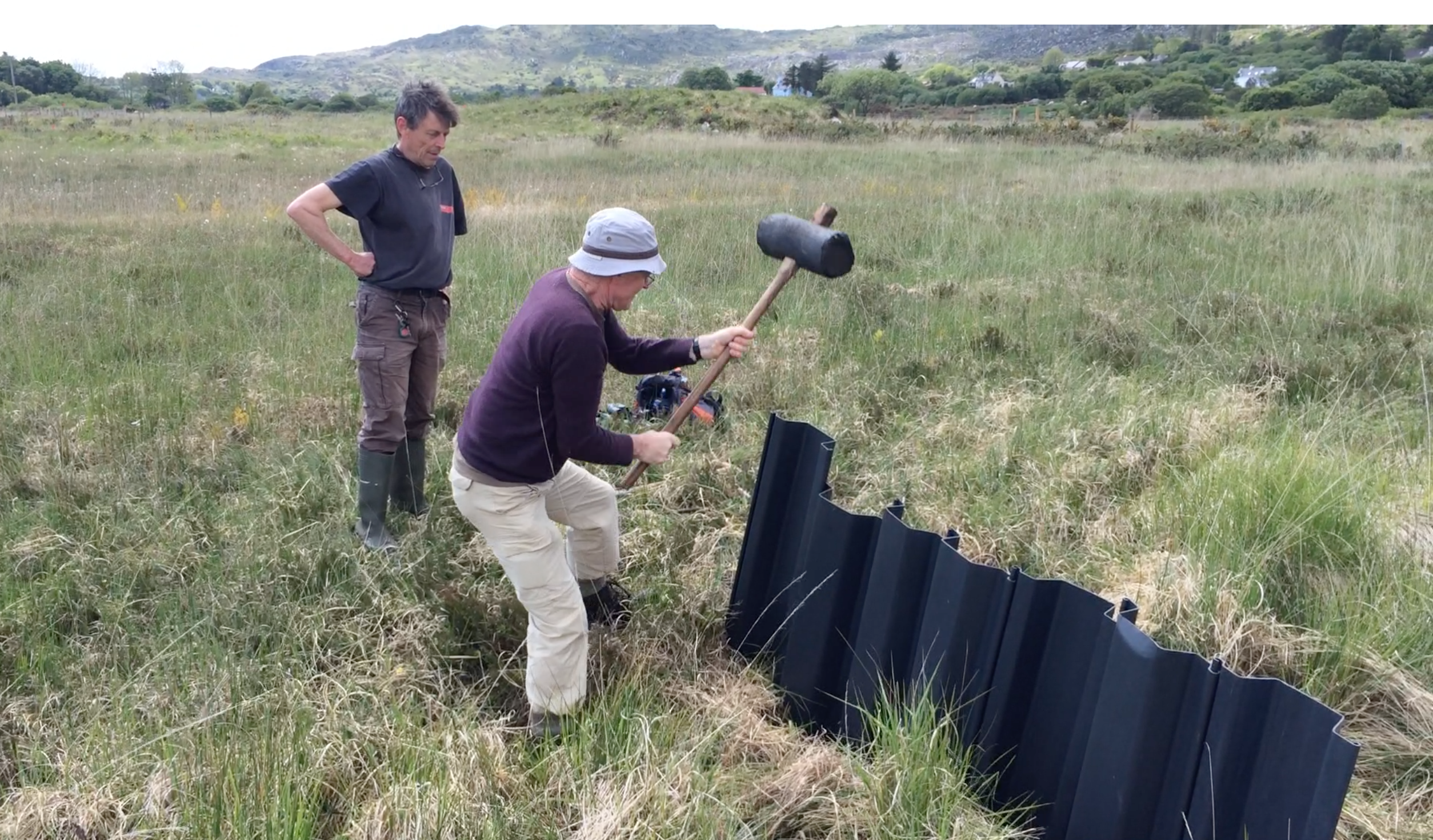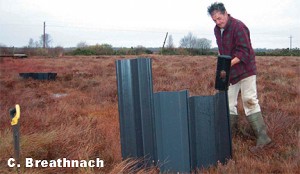 Effects of Drainage on Peatlands
Effects of Drainage on Peatlands
In its natural state a bog is 95% to 98% water. Drainage removes water and increases the dry matter content of the peat. This causes shrinkage of the peat. The bog sinks. Sometimes the bog can even implode a little like a big bubble bursting. Studies undertaken by the National Parks and Wildlife Service at Clara Bog, Co. Offaly have shown that the bog has subsided by as much as 5 to 6m depth alongside a main drain and the effects of the subsidence are in evidence at a distance of 500m from the drain itself. Cracking of the peat is commonly associated with subsidence. Subsidence of the peat and cracking increases the slope of the bog surface and this increases the discharge of water.
Drainage removes water from the peat lowering the water table. Studies at Wedholme Flow in the UK by English Nature showed that each drain inserted, had the effect of lowering the water table over the entire site from 10cm to 30cm or more. This destroys the acrotelm, the upper layer of the bog which contains the living Sphagnum mosses, the peat forming community. As a result the bog loses its peat forming capacity. The vegetation changes from a Sphagnum dominated community to a vegetation type dominated by dry bog species such as heathers, and sometimes colonisation by birch trees follows. Once peat is exposed to air by drainage, it begins to break down. Oxygen in the air makes it possible for bacteria to digest the peat. Carbon is released during decomposition. Drying of the peat and decomposition changes it structurally, making it difficult to re-wet and therefore unsuitable for re colonisation with Sphagnum mosses.
Drainage also causes the bog pools to dry up with the result that the associated plant and animal communities also disappear. The dry conditions in the bog caused by drainage also make it more susceptible to fire damage. Another detrimental effect to the bog is caused by the practice of mechanically spreading turf to dry on the bog surface. This damages the vegetation which may die due to the shading effect and damage caused by compaction which affects the bog as a whole.
Restoration Measures
The first step in restoration of drained peatlands is to undertake a survey to determine the slope of the drains on the peatland. This is called levelling the drains. A professional survey team will use electronic equipment. Depending on the availability of both resources and time, drains can be levelled using three metre sticks and a spirit level. On the bank of the drain the first metre stick is held in place vertically. The second metre stick is placed one metre further along the bank of the drain. The vertical difference between the two metre sticks is measured by placing the third metre stick horizontally from the top of the lowest metre stick to the second metre stick. The spirit level is used to ensure the third horizontally placed metre stick is level. The difference in height between the two vertical metre sticks is recorded in relation to the first. The profile graph obtained shows the changing slope of the drain on the bog. With regard to dam frequency, the rule of thumb is to insert a dam for every 10cm drop in the level of the drain with a minimum of three and maximum of ten dams per 100m length of drain. The objective of daming the drains is to bring the water table on the bog up so that it is within 10cm of the bog surface. Such a height is necessary to allow for subsequent growth of peat forming plants.
| Height levelling of a peatland surface. The length of A indicates the distance the surface rises or falls over 1m. |  |
Drains can be dammed using plastic drain piling or highly humified (decomposed) peat or a composite of both materials depending on local conditions. Peat dams are the cheapest type of dam to construct and are the type that are most commonly used, however they are not completely impermeable. The National Parks and Wildlife Service have extensively used peat dams on raised and blanket bogs. Peat dams constructed by hand are limited to drains less than 1m wide. Excavator machinery is needed for the construction of wider dams, however site managers need to take precautions to ensure that a fragile bog surface is not irreversibly damaged by machines carrying heavy loads of humified peat. Never use dried out or unconsolidated peat in the construction of a peat dam. Only highly humified, fully waterlogged peat should be used to construct a dam. As the peat is inserted into the drain, it should be compacted. Upon completion it is raised 30cm above the surface of the bog. It should be covered with a living layer of peatland vegetation. The width of the peat dam is generally between 50 and 75cm.
 Plastic drain piling is a good alternative to peat. IPCC have used it extensively on our nature reserve at Lodge Bog in Co. Kildare as shown in the photograph inset. Coillte have used it extensively on formerly afforested sites where there was no peat available to construct dams. Plastic drain piling is impermeable, light, sturdy and easy to transport. It can be purchased in lengths up to 3m. Sheets of the piling measuring 30cm wide interlock with one another using a tongue and groove system. They can be hammered into a drain individually using a large rubber mallet.
Plastic drain piling is a good alternative to peat. IPCC have used it extensively on our nature reserve at Lodge Bog in Co. Kildare as shown in the photograph inset. Coillte have used it extensively on formerly afforested sites where there was no peat available to construct dams. Plastic drain piling is impermeable, light, sturdy and easy to transport. It can be purchased in lengths up to 3m. Sheets of the piling measuring 30cm wide interlock with one another using a tongue and groove system. They can be hammered into a drain individually using a large rubber mallet.
Following blocking with dams, it may be necessary to insert a series of dipwells or piezometers on the bog so as to monitor the height of the water table and the effectiveness of the drain blocking programme. Please follow the link to Monitoring for techniques in this regard. IPCC have been monitoring the effectiveness of drain blocking on Lodge Bog since 2005 and presented a poster paper on the success of the method in re-establishing peat forming vegetation in the drains in 2017 to the International Peatland Society (see Lodge Bog Restoration).
Text, Photographs and Images © Irish Peatland Conservation Council, Bog of Allen Nature Centre, Lullymore, Rathangan, Co. Kildare. Email: bogs@ipcc.ie; Tel: +353-45-860133.
